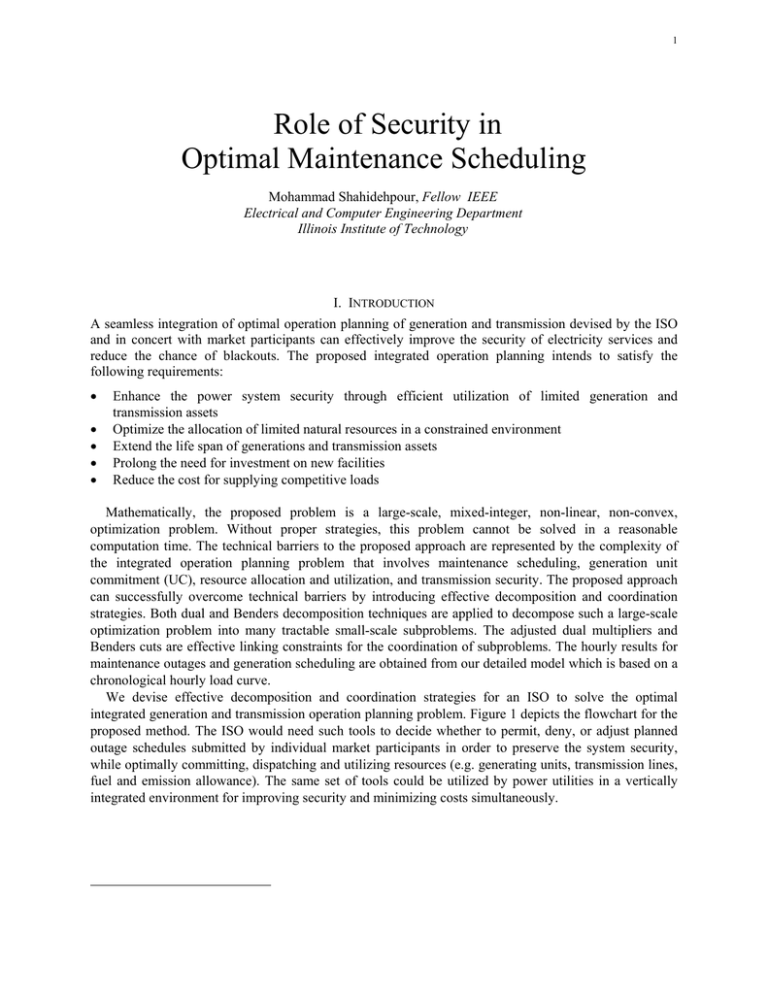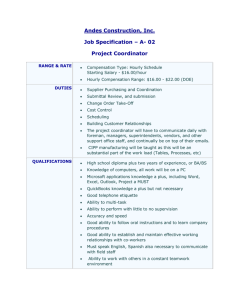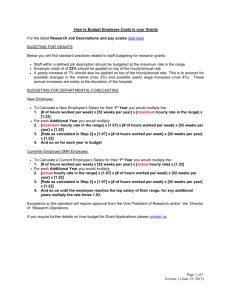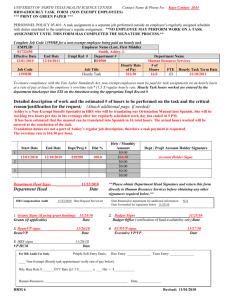Role of Security in Optimal Maintenance Scheduling
advertisement

1 Role of Security in Optimal Maintenance Scheduling Mohammad Shahidehpour, Fellow IEEE Electrical and Computer Engineering Department Illinois Institute of Technology I. INTRODUCTION A seamless integration of optimal operation planning of generation and transmission devised by the ISO and in concert with market participants can effectively improve the security of electricity services and reduce the chance of blackouts. The proposed integrated operation planning intends to satisfy the following requirements: • • • • • Enhance the power system security through efficient utilization of limited generation and transmission assets Optimize the allocation of limited natural resources in a constrained environment Extend the life span of generations and transmission assets Prolong the need for investment on new facilities Reduce the cost for supplying competitive loads Mathematically, the proposed problem is a large-scale, mixed-integer, non-linear, non-convex, optimization problem. Without proper strategies, this problem cannot be solved in a reasonable computation time. The technical barriers to the proposed approach are represented by the complexity of the integrated operation planning problem that involves maintenance scheduling, generation unit commitment (UC), resource allocation and utilization, and transmission security. The proposed approach can successfully overcome technical barriers by introducing effective decomposition and coordination strategies. Both dual and Benders decomposition techniques are applied to decompose such a large-scale optimization problem into many tractable small-scale subproblems. The adjusted dual multipliers and Benders cuts are effective linking constraints for the coordination of subproblems. The hourly results for maintenance outages and generation scheduling are obtained from our detailed model which is based on a chronological hourly load curve. We devise effective decomposition and coordination strategies for an ISO to solve the optimal integrated generation and transmission operation planning problem. Figure 1 depicts the flowchart for the proposed method. The ISO would need such tools to decide whether to permit, deny, or adjust planned outage schedules submitted by individual market participants in order to preserve the system security, while optimally committing, dispatching and utilizing resources (e.g. generating units, transmission lines, fuel and emission allowance). The same set of tools could be utilized by power utilities in a vertically integrated environment for improving security and minimizing costs simultaneously. 2 Mid-term Operation Planning MP1 Optimal Maintenance Schedule (MP2) Maintenance Schedule Shadow Prices Optimal Allocation of Limited Fuel and Emission Allowance (SP2) Optimal Maintenance Schedule and Resource Allocation Infeasibility Cuts Transmission Security Evaluation (SP1) Optimal Maintenance Schedule and Resource Allocation Penalty Prices Short-term Operation Short-term SCUC (week n) Short-term SCUC (week 1) Fig. 1 Flowchart of the proposed method II. CASE STUDIES We analyze a 6-bus system to illustrate the performance of the proposed optimal operation planning. We consider seven days (168 hours) as the study horizon. The 6-bus test system, depicted in Fig. 2 consists of three units, four transmission lines, two tap-changing transformers, one phase shifter, and three load sides presented in Tables 1 through 4. Fig. 3 shows the load profile in which the daily peak load occurs at hour 18. We notice that the weekend load is lower than that of weekdays. The maintenance data are given in Table 5. The generator maintenance is done within seven days and only one unit can be on maintenance at any hour according to the available crew and maintenance resource constraints. The maintenance of transmission line 1-2 will be between Tuesday and Saturday. In this system, like generator maintenance, no partial maintenance is permitted for transmission maintenance. The hourly maintenance cost is listed in Table 6. 1 G1 2 G2 T1 L1 3 P1 4 L2 5 T2 Fig. 2. The 6-bus system L3 6 G3 3 157 144 131 118 105 92 79 66 53 40 27 1 14 MW 280 260 240 220 200 180 160 140 120 100 Hour Fig. 3 Load profile over the study 168 hours for 6-bus system TABLE 1 TRANSMISSION LINE DATA Line From Bus 1 1 2 5 Line 1 Line 2 Line 3 Line 4 TABLE T. T1 T2 P1 To Bus 2 4 4 6 R (pu) X (pu) 0.0050 0.0030 0.0070 0.0020 0.170 0.258 0.197 0.140 Limit (MW) 200 200 80 100 2 TAP CHANGING AND PHASE SHIFTING TRANSFORMER DATA From Bus 2 4 3 To Bus 3 5 6 X (pu) 0.037 0.037 0.018 Max Tap /Degree 1.08 1.08 30 Min Tap /Degree 1.02 1.02 -30 Limit (MW) 100 100 100 TABLE 3 EQUIPMENT MAINTENANCE LIMITS FOR 6-BUS SYSTEM Equip. U1 U2 U3 L1-2 From/ At Bus 1 2 6 1 To Bus 2 Windows Mon. - Sun. Mon. - Sun. Mon. - Sun. Tue. - Sat. Duration (hours) 24 24 24 24 Cost ($/hour) 84 125 167 2080 TABLE 4 GENERATOR DATA Units Bus No. G1 G2 G3 1 2 6 A (Mbtu) 176.9 129.9 137.4 Unit Cost Coefficients b C (MBtu/MWh) (MBtu/MW2h) 13.5 0.00045 32.6 0.001 17.6 0.005 TABLE 5 INITIAL UNIT MAINTENANCE SCHEDULE Unit 1 2 3 Hours on Maintenance 117-140 79-102 2-25 Pmax (MW) Pmin (MW) 220 150 100 100 50 20 Min Down (h) 4 3 1 Min Up (h) 4 2 1 Ramp (MW/h) 55 50 40 4 TABLE 6 HOURLY EQUIPMENT MAINTENANCE SCHEDULE IN CASES 1-3 Case 1 2 3 U1 145-168 121-144 U2 91-114 31-54 U3 119-142 145-168 L1-2 119-142 120-143 In order to show the effectiveness of the proposed approach, we study the following four optimal operation planning cases for a 168-hour period: Case 0: without any equipment maintenance Case 1: with generator maintenance Case 2: with transmission maintenance Case 3: with generator and transmission maintenance Case 0: First we run Case 0 as base case. We notice that the economical unit 1 is committed over the entire 168 hours to support the base load. The most expensive unit 2 is always OFF during this week and unit 3 is partially committed in order to minimize the operation cost. Fig. 4 shows the status of unit 3 during 168 hours, in which 0/1 represents OFF/ON status and unit 3 is committed for a total of 73 hours. The hourly commitment of units is shown in Table 7. Then, we check transmission network violations for the given generation commitment. According to the hourly dc network security, the given commitment with a total cost of $522,237.32 is optimal and satisfies line flow constraints as there are no hourly mismatch violations. TABLE 7 HOURLY COMMITMENT OF UNITS IN CASE 0 Unit 1 2 3 Mon. 1-24 Tue. 25-48 Wed. 49-72 Thu. 73-96 Fri. 97-120 8-21 32-46 56-70 80-94 104-117 Sat. 121-144 Sun. 145-168 Sat. 121-144 Sun. TABLE 8 HOURLY COMMITMENT OF UNITS IN CASE 1 Unit 1 2 3 Mon. 1-24 Tue. 25-48 Wed. 49-72 Thu. 73-96 Fri. 97-120 8-21 32-46 56-70 80-94 104-117 145-168 145-168 TABLE 9 HOURLY COMMITMENT OF UNITS IN CASE 2 Unit 1 2 3 Mon. 1-24 Tue. 25-48 Wed. 49-72 Thu. 73-96 Fri. 97-120 Sat. 121-144 8-21 32-46 56-70 80-94 104-117 137-140 Off/On 1 0 1 21 41 61 81 101 121 141 161 Hours Fig. 4 The status of unit 3 over 168 hours Sun. 145-168 5 TABLE 10 HOURLY COMMITMENT OF UNITS IN CASE 3 Unit 1 2 3 Mon. 1-24 Tue. 25-48 Wed. 49-72 Thu. 73-96 Fri. 97-120 8-21 32-46 56-70 80-94 104-117 Sat. Sun. 145-168 121-144 121-144 Case 1: In this case, we schedule the maintenance outage of three generating units. We first calculate the generation maintenance schedule independent of the unit commitment schedule given in Case 0. The initial generator maintenance schedule is shown in Table 5. In this initial calculation, the production cost is not included in the generator maintenance module, and the maintenance of unit 1 is scheduled during hours 117-140, unit 2 during hours 79-102, and unit 3 during hours 2-25. In this case, the uncoordinated maintenance outage and commitment schedules are clashing because units 1 and 3 cannot be committed during hours 117-140 and hours 2-21 when they are also scheduled for maintenance outage. Now we calculate the generator maintenance schedule based on our proposed method. After 76 iterations, a converged and optimal solution is reached for Case 1 which satisfies hourly commitment, hourly maintenance outages, and hourly transmission network security constraints. Tables 6 and 8 show the final generator maintenance and unit commitment schedules, respectively, for Case 1. When the economical unit 1 is on maintenance outage during hours 145-168, more expensive units 2 and 3 will be committed to deliver hourly loads. In addition, the maintenance of units 2 and 3 is scheduled during hours 91-114 and hours 119-142, respectively, since unit 1 is supplying the load. The primal cost of $578,300.61 includes a generation maintenance cost of $9,024.00 and the operation cost of $569,276.61. Case 2: In this case, we schedule the maintenance outage of transmission line 1-2. We first schedule the transmission maintenance outage independent of unit commitment schedule. As a result, the line can be on maintenance during hours 75-98. However, the commitment schedule of Case 1 will not satisfy transmission network security constraints during hours 1-168 when line 1-2 is on maintenance. In other words, line 1-4 is unable to deliver the generation of unit 1 to loads during hours 80-93 when line 1-2 is on maintenance outage. The maintenance of line 1-2 is now scheduled during hours 97-120. However, transmission network security constraints are not yet satisfied during hours 104-109 and 110-118. The procedure will continue until the optimal commitment solution can satisfy hourly transmission network security. Finally, in the transmission maintenance window, a low-load period during hours 119-142 is selected for the maintenance of line 1-2. Table 11 shows transmission maintenance schedule violated hours at each Benders iteration. Table 9 show the final 168-hour generating unit commitment in Case 2 when line 1-2 is on maintenance. In order to guarantee the transmission system security when transmission line is on maintenance outage, unit 3 is committed between hours 137-140 to satisfy its ramping constraint. The total primal cost is $573,719.84, which consists of the transmission maintenance cost of $49,920.00 and the operation cost of $523,799.84. TABLE 11 MAINTENANCE OF LINE 1-2 AND HOURLY VIOLATIONS Iteration 1 2 3 4 5 6 Hours on Maintenance 75-98 97-120 56-79 119-142 25-48 119-142 Hours with Violation 80-93 104-109, 110-118 56-70 138-140 31-47 None Case 3: In this case, we schedule simultaneously the maintenance of generators and transmission line that were considered in Cases 1 and 2. We ought to use our proposed method to determine the optimal maintenance schedule. However, let us combine generator and transmission maintenance schedules given in Cases 1 and 2 (see Table 12) to see if the combined schedule satisfies our constraints. Accordingly, we utilize the final unit commitment given in Case 1 for checking the transmission security constraints when 6 line 1-2 is on maintenance. In this case, the proposed maintenance schedule will result in a feasible solution for network flows. In other words, there are no network flow violations. The total primal cost is $632,417.53 with a maintenance cost of $58,944.00 and the operation cost of $573,473.53. In this case, we find that the expensive units 2 and 3 are committed on Sunday when unit 1 is on maintenance and unit 3 is also committed during hours 137-140 when the line 1-2 is on maintenance. However, the combined maintenance schedule does not result in an optimal commitment solution. Now we apply our proposed approach to obtain more economical maintenance and commitment schedules as shown in Tables 6 and 10, respectively. The primal cost in this case is $629,987.94. Note that the maintenance cost is not reduced but the operation cost is dropped to $571,043.94. In this optimal case, the commitment of expensive units 2 and 3 will replace that of unit 1 when unit 1 is on maintenance on Saturday and guarantee a secure power transmission when line 1-2 in on maintenance. As a result, the maintenance of unit 1 is shifted from Sunday to Saturday, and that of unit 3 from hours 119-142 to hours 145-168. The summary of costs incurred in all cases is presented in Table 12. TABLE 12 SUMMARY OF COSTS ($) FOR ALL CASES Case 0 1 2 3 (Feasible) 3 (Optimal) Maint. Cost 0.00 9,024.00 49,920.00 58,944.00 58,944.00 Oper. Cost 522,237.32 569,276.61 523,799.84 573,473.53 571,043.94 Total Cost 522,237.32 578,300.61 573,719.84 632,417.53 629,987.94 III. CONCLUSIONS There has been a strong need for a theoretically sound scheme for coordinating security, optimal generation scheduling, resource allocation and equipment maintenance. An integrated optimal operation planning is proposed in this paper to meet critical components which can be seamlessly integrated and efficiently coordinated by the ISO. The proposed approach uses a chronological hourly load curve. The tests on a 6-bus system and the IEEE 118-bus system show the effectiveness of the proposed approach which can successfully coordinate and solve the optimal operation planning in restructured power market. Major technical characteristics of the proposed method include: 1. It solves equipment maintenance scheduling, generation unit commitment, resource allocation and utilization, and transmission security in an integrated framework. 2. The rigorous mathematical decomposition and coordination strategies are applied to solve the integrated problem with large-scale, mixed-integer, and nonlinear properties. 3. The optimization components are relatively independent and the decomposition strategy is flexible enough to be tailored for different market and user requirements. IV. REFERENCES [1] M. Shahidehpour and Y. Wang, Communication and Control of Electric Power Systems, John Wiley and Sons, Jun. 2003. [2] M. Shahidehpour, H. Yamin, and Z.Y. Li, Market Operations in Electric Power Systems, John Wiley &Sons, Inc., New York, 2002. [3] M. Shahidehpour and M. Marwali, Maintenance Scheduling in Restructured Power Systems, Kluwer Academic Publishers, Norwell, Massachusetts, 2000. [4] Y. Fu, M. Shahidehpour and Z. Li, “Long-term Security-constrained Unit Commitment: Hybrid Subgradient and Danzig-Wolfe Decomposition,” IEEE Transactions on Power Systems, Vol. 20, No. 4, Nov. 2005.


